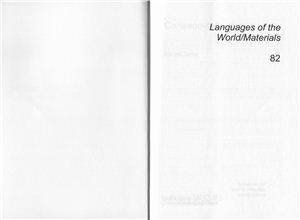Lincom, 2005. - 82 p.
During the second millenium BCE, Akkadian served as the lingua franca of the ancient Near East. An extensive body of epistolographic texts written in this language was discovered at Tell el-Amaa, the mode name for the ancient seat of govement of the Egyptian Pharaoh Amenophis IV (Akhenaton). The majority of the Amaa letters were sent to Egypt by the rulers of Canaanite cities which, at the time, were part of the Egyptian empire.
While the conventional language of correspondence was nominally Akkadian, by the Amaa period, i.e. , the 14th century BCE, the Canaanite administration had developed a kind of mixed language. This language, or rather, linguistic continuum comprising many varieties, was based upon the lexicon of Akkadian, with serious structural interference from the scribes' primary languages, i.e. , the spectrum of West Semitic dialects spoken in Canaan. As a result of this language contact, all levels of the linguistic structure were affected, especially in the domains of syntax and morphology, creating a marked similarity between this mixed Canaano-Akkadian diplomatic language and the indigenous West Semitic Canaanite dialects.
Since we do not possess any substantial written record of the Canaanite dialects prior to the first millennium BCE, the Amaa letters from Canaan are our only source of knowledge regarding the linguistic structure of the dialects spoken in Canaan in the second millenium BCE. The Amaa letters yield linguistic, sociolinguistic and linguistic-cultural material that predates both Phoenician and Hebrew as we know them from the written records of the first millenium BCE.
The survey offered in LW/M, which sketches a concise model of the linguistic system embodied by this corpus, lays special stress on the interference between Akkadian and the West Semitic languages, which resulted in the Canaano-Akkadian mixed languages and linguistic varieties.
During the second millenium BCE, Akkadian served as the lingua franca of the ancient Near East. An extensive body of epistolographic texts written in this language was discovered at Tell el-Amaa, the mode name for the ancient seat of govement of the Egyptian Pharaoh Amenophis IV (Akhenaton). The majority of the Amaa letters were sent to Egypt by the rulers of Canaanite cities which, at the time, were part of the Egyptian empire.
While the conventional language of correspondence was nominally Akkadian, by the Amaa period, i.e. , the 14th century BCE, the Canaanite administration had developed a kind of mixed language. This language, or rather, linguistic continuum comprising many varieties, was based upon the lexicon of Akkadian, with serious structural interference from the scribes' primary languages, i.e. , the spectrum of West Semitic dialects spoken in Canaan. As a result of this language contact, all levels of the linguistic structure were affected, especially in the domains of syntax and morphology, creating a marked similarity between this mixed Canaano-Akkadian diplomatic language and the indigenous West Semitic Canaanite dialects.
Since we do not possess any substantial written record of the Canaanite dialects prior to the first millennium BCE, the Amaa letters from Canaan are our only source of knowledge regarding the linguistic structure of the dialects spoken in Canaan in the second millenium BCE. The Amaa letters yield linguistic, sociolinguistic and linguistic-cultural material that predates both Phoenician and Hebrew as we know them from the written records of the first millenium BCE.
The survey offered in LW/M, which sketches a concise model of the linguistic system embodied by this corpus, lays special stress on the interference between Akkadian and the West Semitic languages, which resulted in the Canaano-Akkadian mixed languages and linguistic varieties.

